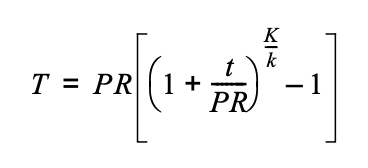
WHERE:
T = insulation thickness for material with conductivity K, inches.
PR = actual outside radius, inches.
t = Insulation thickness from Table 120.3-A, inches.
K = Conductivity of alternate material at the mean rating temperature indicated in Table 120.3-A for the applicable fluid temperature range, in Btu-inch per hour per square foot per °F.
k = The lower value of the conductivity range listed in Table 120.3-A for the applicable fluid temperature range, Btu-inch per hour per square foot per °F.
|
Fluid Operating Temperature Range |
Insulation Conductivity |
Nominal Pipe Diameter (in inches) | |||||||||
|
Conductivity |
Mean Rating Temperature (°F) | ||||||||||
|
< 1 |
1 to <1.5 |
1.5 to < 4 |
4 to < 8 |
8 and larger | |||||||
|
Space heating and Service Water Heating Systems (Steam, Steam Condensate, Refrigerant, Space Heating, Service Hot Water) |
Minimum Pipe Insulation Required (Thickness in inches or R-value) | ||||||||||
|
Above 350 |
0.32-0.34 |
250 |
Inches |
4.5 |
5.0 |
5.0 |
5.0 |
5.0 | |||
|
R-value |
R 37 |
R 41 |
R 37 |
R 27 |
R 23 | ||||||
|
251-350 |
0.29-0.32 |
200 |
Inches |
3.0 |
4.0 |
4.5 |
4.5 |
4.5 | |||
|
R-value |
R 24 |
R 34 |
R 35 |
R 26 |
R 22 | ||||||
|
201-250 |
0.27-0.30 |
150 |
Inches |
2.5 |
2.5 |
2.5 |
3.0 |
3.0 | |||
|
R-value |
R 21 |
R 20 |
R 17.5 |
R 17 |
R 14.5 | ||||||
|
141-200 |
0.25-0.29 |
125 |
Inches |
1.5 |
1.5 |
2.0 |
2.0 |
2.0 | |||
|
R-value |
R 11.5 |
R 11 |
R 14 |
R 11 |
R 10 | ||||||
|
105- 140 |
0.22-0.28 |
100 |
Inches |
1.0 |
1.5 |
1.5 |
1.5 |
1.5 | |||
|
R-value |
R 7.7 |
R 12.5 |
R 11 |
R 9 |
R 8 | ||||||
|
Space cooling systems (chilled water, refrigerant and brine) |
Minimum Pipe Insulation Required (Thickness in inches or R-value)1 | ||||||||||
|
40-60 |
0.21-0.27 |
75 |
Inches |
Nonres 0.5 |
Res 0.75 |
Nonres 0.5 |
Res 0.75 |
1.0 |
1.0 |
1.0 | |
|
R-value |
Nonres R 3 |
Res R 6 |
Nonres R 3 |
Res R 5 |
R 7 |
R 6 |
R 5 | ||||
|
Below 40 |
0.20-0.26 |
50 |
Inches |
1.0 |
1.5 |
1.5 |
1.5 |
1.5 | |||
|
R-value |
R 8.5 |
R 14 |
R 12 |
R 10 |
R 9 | ||||||
|
Footnote to Table 120.3-A: 1 These thickness are based on energy efficiency considerations only. Issues such as water vapor permeability or surface condensation sometimes require vapor retarders or additional insulation. | |||||||||||


